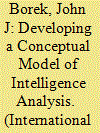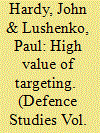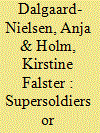| Srl | Item |
| 1 |
ID:
167479


|
|
|
| 2 |
ID:
114616


|
|
|
|
|
| Publication |
2012.
|
| Summary/Abstract |
There is a common theme in literature about High-Value Targeting (HVT): that it does not work. In order to make an informed judgment on the use of HVT in irregular war against networked opponents, an accurate analytical framework is required. This article proposes a conceptual model that recognizes HVT as: subordinate to strategic objectives, a shaping and enabling tool, rather than a decisive tool, and fuelled by a robust, intelligence-led targeting cycle. It identifies three methods of conducting HVT: pressuring, leveraging, and desynchronizing, and argues that there is a significant and underappreciated potential for complementarity between HVT and non-kinetic operations in irregular warfare.
|
|
|
|
|
|
|
|
|
|
|
|
|
|
|
|
| 3 |
ID:
153751


|
|
|
|
|
| Summary/Abstract |
The paper analyzes the foreign practice of CALS (Continuous Acquisition and Lifecycle Support) contracts. It offers a conceptual model of controlling the life cycle of products, which is to include the professional training of communication combat unit personnel of Navy surface ships (SS). It recommends creating a virtual learning environment for Navy specialists when taking up end-to-end lifecycle contracts. The authors conclude that these measures are necessary.
|
|
|
|
|
|
|
|
|
|
|
|
|
|
|
|
| 4 |
ID:
169095


|
|
|
|
|
| Summary/Abstract |
Special Operations Forces (SOFs) are increasingly central in national defense postures worldwide. The term “SOF mind-set” encapsulates the current political enthusiasm but is rarely explicitly defined or systematically studied. Based on a literature review, this article suggests a conceptual model of SOF’s mind-set, which is refined via a Danish case study. It discusses when and where this mind-set complicates collaboration with the wider military organizational environment and how SOF could navigate potential fault lines. By systematically unpacking SOF’s mind-set, the article aims to add nuance to polarized conceptions and stereotypes.
|
|
|
|
|
|
|
|
|
|
|
|
|
|
|
|
| 5 |
ID:
175710


|
|
|
|
|
| Summary/Abstract |
Our article challenges a common discourse that terrorist groups are relatively disinterested in territory by exploring emerging theories about territory and territoriality. We use these theories to introduce a new conceptual model of the importance of territory for terrorism that contrasts a group’s Sovereignty Claims over Territory (SCOT), which corresponds with the ultimate territorial aims of the group, with its Effective Control of Territory (ECOT), which relates to the ability of an organization to exert influence over a particular territory. Contrasting these dimensions of territory allows us to develop several archetypes of territorially-motivated terrorism. Our model predicts that, in contrast to common deterritorial discourses, truly non-territorial terrorism is likely to be quite rare as most groups engaged in violence have territorial ambitions in one way or another. We then use our model to interrogate the salience of territory to three representative cases: the Islamic State, ETA, and FARC-EP. Our analysis shows that territory remains a central motivating factor for these groups as their overall territorial aims tend to remain constant whereas their ability to control territory is more susceptible to change. We conclude by discussing the implications of our model and analysis for future research.
|
|
|
|
|
|
|
|
|
|
|
|
|
|
|
|